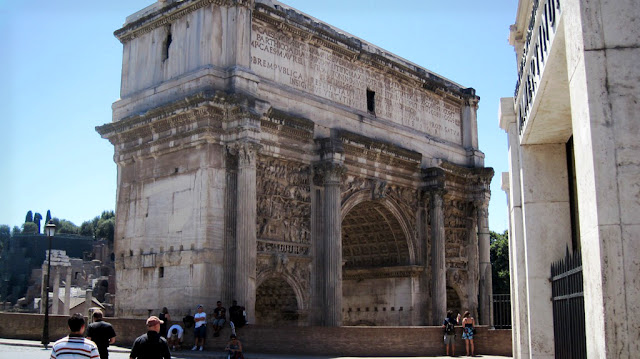Reliving 20 July
We visited another basilica today, the Basilica of San Clemente! St. Clement was the 4th pope, he was martyred
at the end of the 1st century. As it has
gone throughout Rome's history, what you basically do is build on top of
whatever you don't want anymore. This is
why construction projects take so long here, because you can't dig down 20 feet
without stumbling upon some ruins that now render it an excavation site.
The Basilica of St. Clement is no different. It is an 11th century church built upon a 4th
century church, built upon a 1st century home of a Roman nobleman (which served
in the 2nd century as a mithraeum temple), a home that was itself converted
from a previous governmental building that had burned to the ground in 64 A.D. I managed to get one photo inside of the current
basilica before being told that photos were not allowed. Blast.
St. Clement is buried right underneath the main altar. At one point he hung out with the body of St.
Cyril of Alexandria, although St. Cyril has since been moved (a bone fragment
remains in the basilica, however). This
basilica was allegedly one JP II's favorite places to pray. We were able to have Mass at the main sanctuary
and afterwards we got a tour of the basilica and the two levels of excavations
beneath it from an Irish Dominican priest, which must have been divinely
planned because there are no regular tours given of this basilica. We just happened to find him there when we arrived
and he agreed. His order maintains St.
Clement and a few other properties around Rome.
(I wish I remembered all the cool things he said about
the architecture and the history of it, but all this Italian I am currently
learning in Assisi has really hindered my short term memory of these details. Go figure.)
The Basilica of St. Clement is just down the street from
the Colosseum, the Forum, and the rest of ancient Rome, so on our way back to the
college one of the second year men gave us a short tour of the buildings that
were there.
The Colosseum's proper name is the Flavian
Amphitheatre. I like Colosseum. That name is alleged to have come from a massive statue of Nero that stood outside the stadium, modeled after the Colossus of Rhodes. It is enormous, I am dumbfounded as to how
this was built without modern machinery.
Construction began around 70 A.D. and the entire structure, including
later modifications, was completed in 20 years.
What??!
 |
| These are the barracks where the gladiators would train and be housed. The Colosseum is to the left of this photo and about 100 yards away. |
 |
| Impressive monument to the engineering capabilities of Romans. |
The holes that you see along the walls and columns originally housed bronze
clamps. Over the centuries, pieces of the
Colosseum were continually pillaged and repurposed and this metal was ripped
off to be used for military weaponry when it became harder to come by. It is incredible to me being here in Rome and
seeing how much the Romans built things to last. 2000 years later, no big deal. We can't go ten years anymore without
replacing the washing machine.
 |
| Site of the Roman Forum. |
 |
| The Arch of Septimius Severus. Built to commemorate a major military victory of the Emperor Severus in 200 A.D. It is pretty impressive to look at! |
 |
| The Palatine Hill. One of the seven original hills of Rome. This one is often considered the "birth place" of Rome because the community here eventually took over the other six. |
This evening we had a barbecue cookout down by the soccer
field and played some futbol afterward.
It was good to put the cleats on again and run around. Unfortunately the field does not have lights,
so we played until we couldn't see anymore.
Tomorrow we are off to the town of Orvieto, north of Rome and the site
of a 13th century Eucharistic miracle.
Should be another fun day!



No comments:
Post a Comment